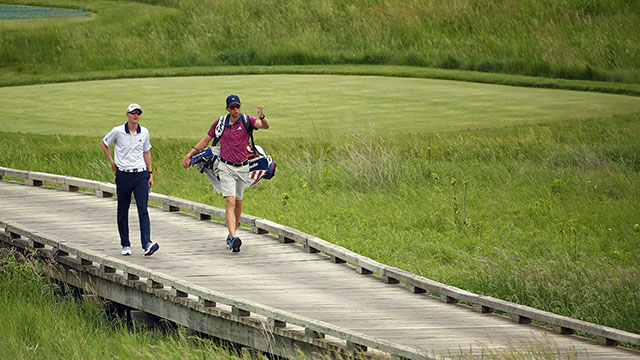NEWS
U.S. Open: Why trying out a brand new course is a familiar concept

ERIN, Wis. — To drive along the two-lane roads that wind through Wisconsin pastures on the way to Erin Hills, to see the rolling terrain of a golf course built on 652 acres that opened only 11 years ago, is sure to pose a natural question.
What is the U.S. Open doing here?
Forget for a moment that very few Americans were even aware of golf at the time, and the same could have been said about that two-lane road that led to Shinnecock Hills when it first hosted the U.S. Open.
Then again, that was in 1896. The U.S. Open was in its second year.
What raises questions about Erin Hills is that it's the second time in three years for golf's second-oldest championship to go somewhere new. And it's even more pronounced because the U.S. Open now has 121 years of history behind it.
U.S. Open Predictions: 10 contenders at Erin Hills
"Listen, if you look at our next 10 U.S. Open venues, they are historical, tried-and-true sites that have these wonderful names associated with them," said Mike Davis, the USGA's executive director. "But we relish the idea of occasionally introducing a new golf course, because when you think about it, there's no country in the world that has as many great golf courses as the United States, and we should celebrate that."
What is the U.S. Open doing here?
The short answer is the USGA was lacking a good spot in the Midwest. The U.S. Open has been to Hazeltine and Oakland Hills, both now used more by the PGA of America. It went to Olympia Fields in 2003 and found Chicago politics involving the support staff to be tougher to manage than U.S. Open rough.
And then along came a wonderful piece of property 40 miles west of Milwaukee purchased by Bob Lang, whose dream was to build a public course that could host a U.S. Open. The USGA saw it for the first time late in 2004, and the wheels were set in motion.
Lang's inspiration was "Open," the book by John Feinstein on how Bethpage Black came to host the U.S. Open in 2002 (and later in 2009). David Fay, the former USGA executive director, recalls being in Lang's office in the summer of 2005 when Lang asked if he would sign the book for him.
"Here's hoping a book will be written — in the not-too-distant future (i.e., when we're both alive to enjoy it!) — on the U.S. Open at Erin Hills," Fay wrote.
They're both alive, even though Fay retired (he's working for Fox Sports this week) and Lang had to sell the course a year before it was awarded the Open.
U.S. OPEN: Tee Times, Pairings | Photo Galleries
Only part of the success of Erin Hills will be based on how it plays this week and the quality of the winner.
The real measure is if it returns. Because if it doesn't, how would that look?
"It would have to be a negative," Fay said Tuesday. "My signature was on all those contracts through 2019. I would never go to a place if I were to think it was never going back. I would be disappointed if we didn't return."
Chambers Bay in 2015 had all the drama a U.S. Open could want, ending with Jordan Spieth capturing the second leg of the Grand Slam when Dustin Johnson took three putts from 12 feet on the last hole. What it didn't have was much grass on the greens, a product of either bad weather or bad agronomy, take your pick. It also had one hole where spectators couldn't watch and others where they needed binoculars. Those can be fixed. Either way, Chambers Bay is on the clock.
The idea of going somewhere new is part of U.S. Open history.
When the U.S. Open was still in its infancy, there was a stretch from 1916 (Minikahda) through 1930 (Interlachen) went it was held on courses hosting a U.S. Open for the first time. That was to be expected. With more history behind it, the U.S. Open had 22 straight years of going somewhere it had been before, a streak interrupted by Pinehurst No. 2 in 1999.
Just like now, there were spurts of new sites.
The U.S. Open was at Olympic Club, Oak Hill and Southern Hills for the first time from 1955 to 1958. Those courses now have combined to host the U.S. Open 11 times. There was another stretch like that involving Champions (1969), Hazeltine (1970) and Pebble Beach (1972).
Not all of them were love at first sight.
"All you need is 80 acres of corn and some cows," Dave Hill said when he was runner-up at Hazeltine in 1970.
Hazeltine is where Payne Stewart won his first U.S. Open, and where Tiger Woods lost his first major when he had the 54-hole lead. It's where the Americans captured the Ryder Cup last September. It has more than corn and cows.
Whatever happens this week at Erin Hills, it's worth trying to look it at through a wide lens.
"What Erin Hills doesn't have is history yet," Davis said. "But everybody had to start somewhere."
